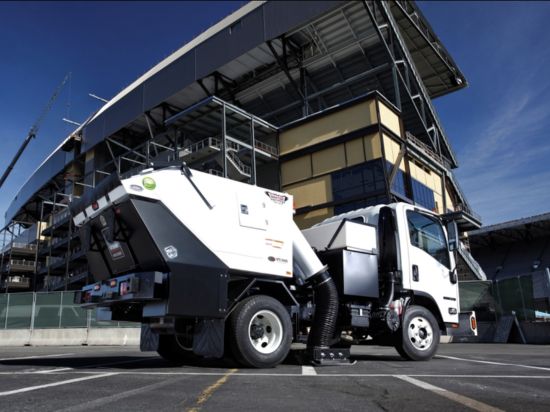Street sweeping is common in modern neighborhoods, storefronts, parking lots, and other locations. Many clients and businesses rely on street sweeping to clean up excess debris, preserve neighborhood and area safety, and maintain the visual appeal of homes and businesses. But how far back does the history of street sweeping go?
Read on to explore a brief, intriguing history of street sweeping and discover how the invention came from humble origins. The concept of street sweeping has helped preserve our quality of life, providing cleaner air and water. The invention of the street sweeping industry has done incredible work in keeping areas clean and maintaining the health of citizens. So, let’s review street sweeping history and how it impacts the people and businesses of today. Before you know it, you’ll understand and appreciate the importance of street sweeping and take notice of their valiant efforts to preserve society as a whole.
The First Introduced Street Sweeper
The invention of the first street sweeps stems back as far as 1843. The early 19th century brought about the Industrial Revolution, where industrial development happened all at once and changed the way of life as society knew it. Manchester comprised the largest textile industry globally, producing the first passenger rail service. However, this rapid industrial expansion made it the unhealthiest place to live due to excess trash littering the streets. Joseph Whitworth pursued this issue by creating the first street cleaner, “The Patent Street Sweeping Machine of Manchester.”
Shortly after its conception, the first street-sweeping machine came to fruition in 1849 by inventor C.S. Bishop. Both street sweeping inventions operated through horse-drawn power, followed by the 1911 motor-driven pickup street sweeper from John M. Murphy. This progress convinced The American Towers and Tank Company from Elgin, Illinois, that the motorized street sweeper would work, thus leading to the founding the Elgin Sweeper Company. They experimented with their street sweepers for two years, then found success, with their first sweeper selling in Boise, Idaho, in 1913. In 1917, John M. Murphey patented the following version with a conveyor belt attachment to carry dirt from the broom to the dirt box.
Where the First Street Sweeper Operated
Street sweeping has an intriguing history in where it operated first. Shortly after the Industrial Revolution, the first street sweeper emerged in Manchester and operated for the first time there. Because of how dirty and trashed the town was from its economic and technological developments, many citizens needed street sweeping for safety, health, and way of life reasons.
The unhealthy aspects of the city stemmed from being the largest textile industry in the world and becoming home to the first passenger railway service. As a result, these developments left behind considerable debris and trash that got out of control. The street-sweeping invention helped preserve the integrity, health, and safety of Manchester, England, which eventually spread to the rest of the world.
Evolution of the Street Sweeper
Street sweepers remained relatively the same in design and performance until the 1970s, then evolved again shortly after in the 1990s. Previous street sweeper iterations primarily removed larger pieces of trash, leaving behind smaller bits. This oversight was due to the belief that smaller debris would wash away with rainfall. However, these smaller pieces of trash would become stormwater pollutants and eventually taint the water. As a result, street-sweeping regulations and design changes ensured the machines caught smaller, harder-to-see debris.
Modern street sweepers now clean up incredibly small debris; some street sweepers have certifications for picking up debris as small as a micron—the size that enters human lungs. Advancements in street sweeper technology improved performance and quality, helping to prevent storm drain and air pollution.
Community Benefits of Street Sweeping
Considering street sweeping’s history, it’s no secret that its incredibly long history has positively impacted society. Read on to explore the various street-sweeping benefits for communities. From preserving water and air quality to maintaining and increasing property value, street sweeping is necessary for all locations.
Preserved Water Quality
Over time, roadways and streets accumulate dirt, debris, and other hazardous materials. Vehicle waste and debris, vegetation, sediment, litter, and industrial emission particle distribution can act as harmful pollutants that can accumulate on parking lots, pavements, and roadways. Street sweeping removes these pollutants and contaminants by performing according to the seasons, determining sweeping frequency, sweeping practices, sweeping types, and more as needed.
Depending on the time of year, street sweeping can significantly help preserve water integrity year-round. For instance, springtime street sweeping helps collect dropped seeds and remove materials contributing to plant nutrient loading. Furthermore, sediment and metal buildup can increase the length of runoff event times, often concentrating in major transportation and industrial work areas. Through performing regular street sweeping, instances of runoff and sewer pollution decrease.
Improved Health and Safety
If there’s one crucial factor of street sweeping, it’s that it helps maintain the health and safety of citizens. Leaving behind materials and waste that linger on community roads can directly impact community health. For instance, hazardous materials can become dangerous, such as harmful nutrients, metals, and other organics that accumulate near homes, businesses, and schools.
These contaminants can eventually get into our food, air, and water, directly impacting community health. Additionally, leftover debris, such as twigs, leaves, dirt, and gravel buildup, can become hazardous for pedestrians and drivers. Roadside debris can result in disrupted traffic, roadblocks, and hazards for cyclists and runners to maneuver. Street sweeping helps to clear roads of debris to reduce safety and health risks.
Wildlife Preservation
Street sweeping protects citizens and residents by keeping roads clear and reducing water contamination. It’s incredibly helpful for people, especially in regard to pavement integrity.
While it’s easy to assume small debris doesn’t impact the environment, our plastics, metals, litter, and pollutants can drastically change the environment for wildlife and aquatic life. Keeping roads clear helps us avoid wildlife deterioration while protecting our streets.
Property Value and Curb Appeal
Having clean parking lots and walkways leading to a storefront or the entrance of a home can help with curb appeal. City streets are among the first things visitors or vacationers notice as they pass through. Visitors will feel less inclined to stop by if your town has overwhelmingly dirty streets.
Investing in street sweeping can help visitors and tourists who want a change of scenery or move into the area. Maintaining storefronts, parking lots, public spaces, and home streets is crucial for bringing in new faces, increasing the population, and boosting business.
CPM Sweeping offers high-quality street-sweeping services in the Carrollton, TX, area. Our industrial sweeping services stop at nothing to ensure clean, pristine parking lots and large industrial complexes. For more information about our sweeping services, contact us today.


